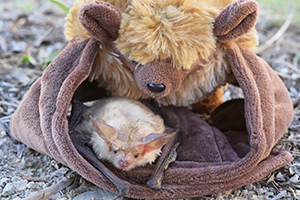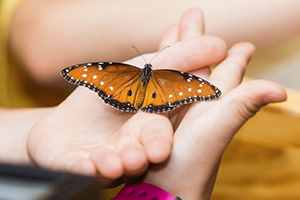Butterflies
Butterflies are one of the most popular and easily recognized groups of insects. Together with moths, they make up one of the major insect orders or groups�Lepidoptera �which number some 160,000 recognized species worldwide. There are over 250 species of butterflies in the Sonoran Desert.
 |
Lepidoptera comes from Greek words meaning scaled and wing. Butterflies and moths can easily be distinguished from other insects by their wings, which are covered with thousands of tiny overlapping scales, much like tiles on a roof. Each scale is one color, but collectively a butterfly�s color pattern is produced by a complex mixture of differently colored scales. Butterflies are usually large, pretty, and diurnal. They are rarely pests, and consequently are well-liked by humans.
Dispersal and Species Richness
There are a number of factors to account for the rich butterfly diversity in the Sonoran Desert. In general, as one approaches the tropics, species richness increases. Also, a varied topography means a corresponding variety of microclimates, rainfall patterns, plant distributions, and therefore butterfly distributions.
The majority of butterfly species in the Sonoran Desert are rather sedentary, occurring in fairly close proximity to their larval foodplants. But at times, for reasons not fully understood, butterflies wander. Some species move at a particular season, some nearly any time. Some species are true migrants, in that individuals push northward early in the season and southward later. However, an interesting array of taxa are influx species, entering the Sonoran Desert yearly from other deserts, thornscrub habitats, and mountain ranges in northwestern Mexico. The strength, time of onset, and duration of the summer rainy season are thought to be responsible for the intensity of this influx phenomenon. Many of these visitors breed in the Sonoran Desert and comprise a significant or even dominant portion of the summer butterfly fauna. Several influx species, however, are on dead-end missions, there being no suitable plants to serve as larval hosts. The fact that there are both indigenous and influx species of butterflies in the Sonoran Desert accounts for the high number of species, and also delights the butterfly enthusiast.
Life Cycle
The life cycle of butterflies is one of the true miracles in nature. Butterfly lives have four distinct stages: egg, caterpillar (or larva), chrysalis (or pupa), and adult. The term describing this series of distinct stages of development is complete metamorphosis, as distinguished from simple or incomplete metamorphosis, in that the animal progresses through life stages which are very similar to each other. (See the �grasshoppers� section for an example of incomplete metamorphosis.)
In most cases, butterflies produce one or more generations (broods) per year. The length of the complete life cycle varies greatly, ranging from weeks to a couple of years or more in desert adapted species. The lifespan of an adult butterfly varies as well, from merely a few days to as long as several months. After mating, butterflies oviposit (lay eggs), either singly or in clusters. Female butterflies typically oviposit on specific groups of related plants that will provide food for the caterpillars. The young caterpillars begin feeding and, because their skins do not expand to accommodate growth, must shed their skins several times. Each stage between molts is called an instar; each instar is larger than the previous one. The final molt produces a pupa, the resting stage during which the animal does not feed but undergoes the amazing transformation into a butterfly. The pupa of many butterflies hangs from a silk button called a cremaster. Other species� pupae are held upright by a silken girdle. Some are disguised (cryptic), being generally green or brown and resembling leaves, stems, or wood. Others are covered in thornlike tubercles or bumps. Just prior to the emergence of the butterfly, the chrysalis usually changes color. Once free of the chrysalis, the butterfly pumps fluid from its swollen body to its shrunken wings. The newly emerged butterfly then lets its wings dry and harden before taking flight in search of food and a mate.
The Importance of Butterflies
Butterflies are important pollinators. They are also good indicators of the ecological quality of a habitat, as they are important components of the food chain, particularly as larvae. Few butterflies are a serious threat to economically important plants. In short, butterflies are benign, aesthetically pleasing, faunal members. In turn, the main threat to butterflies is the destruction and loss of their habitats. The channelization of riparian areas, draining of wetlands, lowering of water tables, growth of cities, and expansion of agriculture all contribute to this habitat loss. Widespread use of pesticides may also threaten healthy butterfly populations.
The Butterfly Families
Swallowtails (Papilionidae):
 |
Swallowtails are mostly tropical and include some of the largest butterflies in the world. Adults of both sexes have 6 walking legs, take nectar readily, and often flutter their wings even while perched. One of our region�s largest butterflies, with a 4 inch (10 cm) wingspread, is the giant swallowtail (Papilio cresphontes, also called Heraclides cresphantes), a brown and yellow species commonly encountered in urban areas. Its larvae, which feed mostly on the leaves of citrus, look much like fresh bird droppings. If the larvae are touched or disturbed, an unpleasant-smelling, y-shaped orange organ called an osmeterium, is everted from just behind the head. This device and the cryptic appearance are adaptations to avoid predators and perhaps parasites.
Another impressive swallowtail is the pipevine swallowtail (Battus philenor), which is slightly smaller than the giant swallowtail. Pipevine swallowtails are commonly encountered March through October. The butterfly�s upper surface is a dark, iridescent blue; the underside is blue with orange spots. The showy, red-orange caterpillars are poisonous due to the compounds taken from the leaves of pipevines (Aristolochia spp.), their larval food plant. The bright colors serve as warnings to would-be predators that the caterpillars are highly distasteful.
Whites and Sulphurs (Pieridae):
Butterflies in this family are small- to medium-sized and most often white, yellow, or orange, with black margins. Some are among the first spring butterflies, even as early as January. Many emerge in a series of broods throughout the year. Still others are influx species during and after the summer monsoons. This family often exhibits mud puddling behavior wherein dozens of individuals group together on a patch of damp mud to drink and take in minerals and salts. One of the more showy species, the southern dogface (Colias cesonia, also called Zeren cesonia), has a distinctive outline of a poodle on each forewing. A common species, the cloudless sulphur (Phoebis sennae), exhibits strong sexual dimorphism in which the males and females have visibly different wing patterns or coloration. Males of this species are bright, clear, lemon yellow, while females are off-white with small dark markings. In addition to sexual dimorphism, some sulphur species, such as the tailed orange (Eurema proterpia), are seasonally dimorphic, there being short and long day-length color patterns evident. Early spring is a good time to search for orange-tips. The Sara orange-tip (Anthocharis sara) and desert orange-tip (Anthocharis cethura) both come to flowering wild mustards, plants that also serve as larval food plants for these butterflies.
Gossamer Wing Butterflies (Lycaenidae):
Lycaenidae is a large family of small butterflies. Despite their size, many are detailed with exquisite markings�truly jewels of the insect world. One of the world�s smallest butterflies, the pygmy blue (Brephidium exile), measures little more than ½ inch (12 mm) from wingtip to wingtip, and is fairly common in our region, especially in disturbed areas. The great blue hairstreak (Atlides halesus) is one of the largest and most spectacular of the gossamer wings, but it is solitary and uncommon. The caterpillars feed on desert mistletoes (Phoradendron spp.). While there are several broods during the year, the best places and times to look for great blue hairstreaks are wherever and whenever desert broom or seep-willow (both Baccharis spp.) are in bloom.
Metalmarks (Riodinidae):
This largely tropical family is extremely diverse in appearance and in species content. Fewer than a dozen species occur in the Sonoran Desert; most of these having metallic spotting on the ventral (underside) surface of the wings. Metalmarks have long antennae for their size and usually perch with their wings opened flat. One species, the Mormon metalmark (Apodemia mormo), is quite variable from one location to the next, but all populations are associated with patches of various buckwheat (Eriogonum species).
Snout Butterflies (Libytheidae):
 |
The single species of snout butterfly that occurs in the Sonoran Desert, the American snout butterfly (Libytheana bachmanii), can have huge population surges, particularly in the summer and fall, though in some years it is nearly absent. It has a wingspan of about 1¾ inch (44 mm) and is easily recognized by the long projecting sense organs called palpi (which resemble snouts) located between the antennae. The larvae feed on desert and netleaf hackberry.
Brush-footed Butterflies (Nymphalidae):
This is a very large and diverse family with most species medium-sized and generally orange and brown. Many well-known butterflies belong to this family, such as fritillaries, painted ladies, crescents, checker-spots, anglewings, admirals, longwings, and of course, monarchs. Nymphalid caterpillars feed on a wide variety of plant families. Most larvae are fiercely spined, and their pupae are usually sharply angled and adorned with silver or gold colors.
The gulf fritillary (Agraulis vanillae) is a large, vividly-colored, orange and black butterfly with brilliant silver spots on the underside. Gulf fritillary caterpillars feed exclusively on passion vines. Planting ornamental passion vines around the house can greatly increase the abundance of these butterflies.
One subgroup of the brushfoots, the milkweed butterflies (Danainae), is probably among the most noted and studied groups of butterflies, since it contains the monarch (Danaus plexippus). This well known species is a remarkably strong flier, migrating great distances every year to overwintering roosts in California and central Mexico. The monarch butterfly is not very common in the Sonoran Desert, but it can be seen regularly in late summer and early fall on its push southward. A much more common resident of the region, the queen (Danaus gilippus), is closely related to the monarch. The larvae of both species feed exclusively on various plants in the milkweed family (Asclepiadaceae). This family of plants is poisonous to most vertebrates, and the milkweed butterflies gain protection by ingesting its leaves.
Skippers (Hesperiidae):
This family is named for its rapid, skipping flight. Skippers are small- to medium-sized, differing from other butterflies in having larger bodies in proportion to the wings. They generally have broader heads and hooked antennae that continue past the clubs rather than ending at them. To some people, skippers resemble moths, being hairier and more robust and generally lacking the gaudy colors and patterns of the other butterfly families. But unlike most moths, most skippers are day-flying or crepuscular. Many skipper larvae feed on grasses. One common garden species, the fiery skipper (Hylephila phyleus), eats Bermuda grass and is common around desert lawns. Another common species, the funereal duskywing (Erynnis funeralis), is mostly dark, with white fringes on the hind wings� edges. It is regular both in towns and in desert arroyos, often in close proximity to woody legumes, the larval hosts. Several skipper species have long tail-like projections on the hindwings. The most common of these, the dorantes long-tail (Urbanus dorantes), is an influx species and is at times abundant in late summer and fall.
| Order: Lepidoptera |
| Suborder: Rhopalocera |
| Families: |
|
Papilionidae, Pieridae, Lycaenidae, Riodinidae, Libytheidae, Nymphalidae, Hesperiidae |
| Sonoran Desert genera: numerous |
| Spanish name: mariposa |
Butterfly or Moth?
Though butterflies and moths appear similar in many respects, there are some ways to distinguish between them. Generally when a butterfly lands and rests on a plant it holds its wings vertically, while moths tend to rest with their wings folded back almost horizontally. Moths have heavy, furred bodies, whereas the butterflies have more delicate, slender bodies with little hair. Butterfly antennae are thin and end with a knob at the tip. Moth antennae are often feathery and without a knob.
Color is not a reliable indicator, as some of the moths, especially the Saturnids, are beautifully colored and some butterflies, such as satyrs and mourning cloaks, have muted coloration. Also, not all moths are night fliers. Some species, such as the buck moths and the Calleta silk moth, fly by day. (You may notice the Calleta moth as it feeds on ocotillo leaves during the summer rainy season. Look for ocotillos stripped of leaves from the top down.)
Both butterflies and moths lay eggs which hatch into caterpillars. These caterpillars molt into a pupa, or resting stage. After a period of time�a few days to a season�the winged adult emerges from the pupal case. Moths tend to construct cocoons, protective silk coverings around themselves, before molting into pupas. Butterflies do not encase themselves in cocoons.










